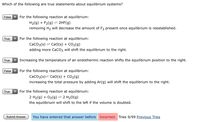
Chemistry
10th Edition
ISBN: 9781305957404
Author: Steven S. Zumdahl, Susan A. Zumdahl, Donald J. DeCoste
Publisher: Cengage Learning
expand_more
expand_more
format_list_bulleted
Question
thumb_up100%
Properties of equilibrium

Transcribed Image Text:Which of the following are true statements about equilibrium systems?
False
For the following reaction at equilibrium:
H2(g) + F2(g) = 2HF(g)
removing H2 will decrease the amount of F2 present once equilibrium is reestablished.
True
For the following reaction at equilibrium:
CaCO3(s)
= CaO(s) + CO2(g)
adding more CaCO3 will shift the equilibrium to the right.
True
Increasing the temperature of an endothermic reaction shifts the equilibrium position to the right.
False
For the following reaction at equilibrium:
CaCO3(s)= Ca0(s) + CO2(g)
increasing the total pressure by adding Ar(g) will shift the equilibrium to the right.
True
For the following reaction at equilibrium:
2 H2(g) + O2(g) = 2 H20(g)
the equilibrium will shift to the left if the volume is doubled.
Submit Answer
You have entered that answer before Incorrect. Tries 9/99 Previous Tries
Expert Solution
This question has been solved!
Explore an expertly crafted, step-by-step solution for a thorough understanding of key concepts.
This is a popular solution
Trending nowThis is a popular solution!
Step by stepSolved in 2 steps with 2 images

Knowledge Booster
Learn more about
Need a deep-dive on the concept behind this application? Look no further. Learn more about this topic, chemistry and related others by exploring similar questions and additional content below.Similar questions
- |For the equilibrium system H2 (g) + CO2 (g) H2O (g) + CO (g), predict the effect that the indicated stress will have on the specified quantity. a) The effect of adding CO on [H2] b) The effect of adding CO2 on [H2] c) The effect of increasing the volume on amount of H2 (g) Do any of the stresses affect the value of K?arrow_forwardIf a reaction proceeds when both X and Y are present, does that automatically mean that the reactionrequires both X and Y? How would you be able to tell which species is/are critical for the reaction to be able to proceed?arrow_forwardis a substance that increases the rate of reaction but has no effect on the equilibrium composition of a reaction mixture. A Moving to another question will save this response.arrow_forward
- Decide whether each of the following statements is true or false. If false, change the wording of the statement to make it true. a) The magnitude of the equilibrium constant is always independent of temperature. b) When two chemical equations are added to give a net equation, the equilibrium constant for the net equation is the product of the equilibrium constants of the summed equations. c) The equilibrium constant for a reaction has the same value as K for the reverse reaction. d) Only the concentration of CO2 appears in the equilibrium expression for the reaction: CaCO3 (s) ↔ CaO (s) + CO2 (g). e) For the reaction CaCO3 (s) ↔ CaO (s) + CO2 (g), the value of K is numerically the same whether the amount of CO2 is expressed as molarity or as gas pressure.arrow_forwardFor the following reaction, write the equilibrium constant expression and indicate the units Sulfur dioxide reacts with oxygen to produce sulfur trioxide (all are gas phase).arrow_forward2. Consider the following equilibrium. Which way will the system shift, if at all? How would the following changes affect the partial pressures of each gas at the new equilibrium, if at all? How will the equilibrium constant change, if at all?arrow_forward
- For an endothermic reaction at equilibrium, increasing the temperature does what?arrow_forwardWhy can an equilibrium be represented mathematically? Please explain!arrow_forward2. Consider the following equilibrium. Which way will the system shift, if at all? How would the following changes affect the partial pressures of each gas at the new equilibrium, if at all? How will the equilibrium constant change, if at all?arrow_forward
- Expline Fundamental equilibrium concepts and it consisted of the explain Le Chatelier’s principle to predict the shift of equilibriumarrow_forwardThe correct equilibrium expression for the reaction of sulfur dioxide gas with oxygen gas to produce sulfur trioxide gas isarrow_forwardThe equilibrium constant changes when... a a catalyst is added. b the temperature changes. c the surface area changes. d the concentration of reactants changes e more than one above is correctarrow_forward
arrow_back_ios
SEE MORE QUESTIONS
arrow_forward_ios
Recommended textbooks for you
 ChemistryChemistryISBN:9781305957404Author:Steven S. Zumdahl, Susan A. Zumdahl, Donald J. DeCostePublisher:Cengage Learning
ChemistryChemistryISBN:9781305957404Author:Steven S. Zumdahl, Susan A. Zumdahl, Donald J. DeCostePublisher:Cengage Learning ChemistryChemistryISBN:9781259911156Author:Raymond Chang Dr., Jason Overby ProfessorPublisher:McGraw-Hill Education
ChemistryChemistryISBN:9781259911156Author:Raymond Chang Dr., Jason Overby ProfessorPublisher:McGraw-Hill Education Principles of Instrumental AnalysisChemistryISBN:9781305577213Author:Douglas A. Skoog, F. James Holler, Stanley R. CrouchPublisher:Cengage Learning
Principles of Instrumental AnalysisChemistryISBN:9781305577213Author:Douglas A. Skoog, F. James Holler, Stanley R. CrouchPublisher:Cengage Learning Organic ChemistryChemistryISBN:9780078021558Author:Janice Gorzynski Smith Dr.Publisher:McGraw-Hill Education
Organic ChemistryChemistryISBN:9780078021558Author:Janice Gorzynski Smith Dr.Publisher:McGraw-Hill Education Chemistry: Principles and ReactionsChemistryISBN:9781305079373Author:William L. Masterton, Cecile N. HurleyPublisher:Cengage Learning
Chemistry: Principles and ReactionsChemistryISBN:9781305079373Author:William L. Masterton, Cecile N. HurleyPublisher:Cengage Learning Elementary Principles of Chemical Processes, Bind...ChemistryISBN:9781118431221Author:Richard M. Felder, Ronald W. Rousseau, Lisa G. BullardPublisher:WILEY
Elementary Principles of Chemical Processes, Bind...ChemistryISBN:9781118431221Author:Richard M. Felder, Ronald W. Rousseau, Lisa G. BullardPublisher:WILEY

Chemistry
Chemistry
ISBN:9781305957404
Author:Steven S. Zumdahl, Susan A. Zumdahl, Donald J. DeCoste
Publisher:Cengage Learning

Chemistry
Chemistry
ISBN:9781259911156
Author:Raymond Chang Dr., Jason Overby Professor
Publisher:McGraw-Hill Education

Principles of Instrumental Analysis
Chemistry
ISBN:9781305577213
Author:Douglas A. Skoog, F. James Holler, Stanley R. Crouch
Publisher:Cengage Learning

Organic Chemistry
Chemistry
ISBN:9780078021558
Author:Janice Gorzynski Smith Dr.
Publisher:McGraw-Hill Education

Chemistry: Principles and Reactions
Chemistry
ISBN:9781305079373
Author:William L. Masterton, Cecile N. Hurley
Publisher:Cengage Learning

Elementary Principles of Chemical Processes, Bind...
Chemistry
ISBN:9781118431221
Author:Richard M. Felder, Ronald W. Rousseau, Lisa G. Bullard
Publisher:WILEY